介词in,on,to,off-方位-表达法
- 格式:ppt
- 大小:488.00 KB
- 文档页数:34
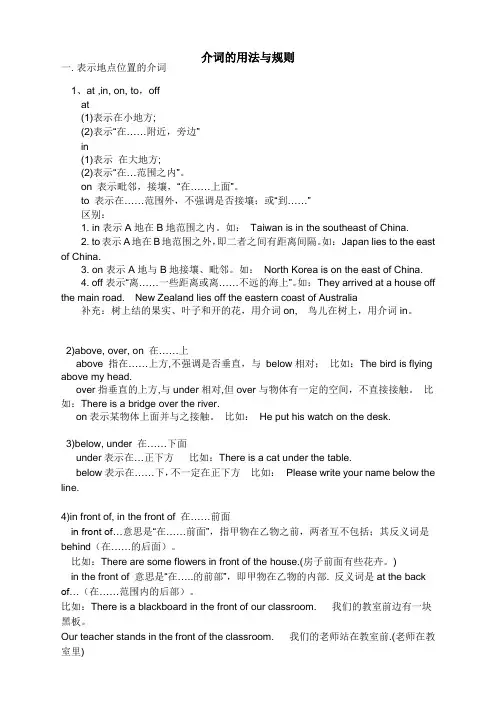
介词的用法与规则一. 表示地点位置的介词1、at ,in, on, to,offat(1)表示在小地方;(2)表示“在……附近,旁边”in(1)表示在大地方;(2)表示“在…范围之内”。
on 表示毗邻,接壤,“在……上面”。
to 表示在……范围外,不强调是否接壤;或“到……”区别:1. in表示A地在B地范围之内。
如:Taiwan is in the southeast of China.2. to表示A地在B地范围之外,即二者之间有距离间隔。
如:Japan lies to the east of China.3. on表示A地与B地接壤、毗邻。
如:North Korea is on the east of China.4. off表示“离……一些距离或离……不远的海上”。
如:They arrived at a house off the main road. New Zealand lies off the eastern coast of Australia补充:树上结的果实、叶子和开的花,用介词on, 鸟儿在树上,用介词in。
2)above, over, on 在……上above 指在……上方,不强调是否垂直,与below相对;比如:The bird is flying above my head.over指垂直的上方,与under相对,但over与物体有一定的空间,不直接接触。
比如:There is a bridge over the river.on表示某物体上面并与之接触。
比如:He put his watch on the desk.3)below, under 在……下面under表示在…正下方比如:There is a cat under the table.below表示在……下,不一定在正下方比如:Please write your name below the line.4)in front of, in the front of 在……前面in front of…意思是“在……前面”,指甲物在乙物之前,两者互不包括;其反义词是behind(在……的后面)。
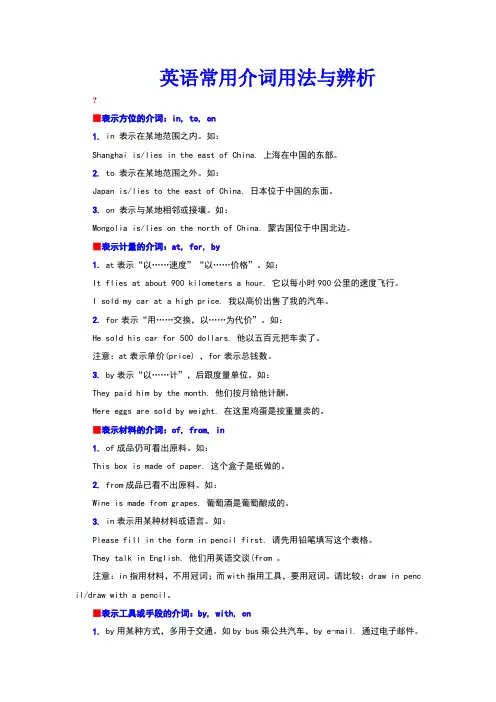
英语常用介词用法与辨析?■表示方位的介词:in, to, on1. in 表示在某地范围之内。
如:Shanghai is/lies in the east of China. 上海在中国的东部。
2. to 表示在某地范围之外。
如:Japan is/lies to the east of China. 日本位于中国的东面。
3. on 表示与某地相邻或接壤。
如:Mongolia is/lies on the north of China. 蒙古国位于中国北边。
■表示计量的介词:at, for, by1. at表示“以……速度”“以……价格”。
如:It flies at about 900 kilometers a hour. 它以每小时900公里的速度飞行。
I sold my car at a high price. 我以高价出售了我的汽车。
2. for表示“用……交换,以……为代价”。
如:He sold his car for 500 dollars. 他以五百元把车卖了。
注意:at表示单价(price) ,for表示总钱数。
3. by表示“以……计”,后跟度量单位。
如:They paid him by the month. 他们按月给他计酬。
Here eggs are sold by weight. 在这里鸡蛋是按重量卖的。
■表示材料的介词:of, from, in1. of成品仍可看出原料。
如:This box is made of paper. 这个盒子是纸做的。
2. from成品已看不出原料。
如:Wine is made from grapes. 葡萄酒是葡萄酿成的。
3. in表示用某种材料或语言。
如:Please fill in the form in pencil first. 请先用铅笔填写这个表格。
They talk in English. 他们用英语交谈(from 。
注意:in指用材料,不用冠词;而with指用工具,要用冠词。
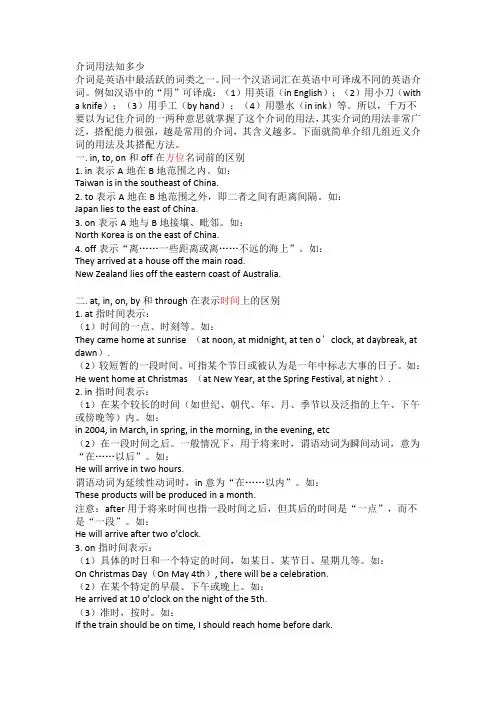
介词用法知多少介词是英语中最活跃的词类之一。
同一个汉语词汇在英语中可译成不同的英语介词。
例如汉语中的“用”可译成:(1)用英语(in English);(2)用小刀(with a knife);(3)用手工(by hand);(4)用墨水(in ink)等。
所以,千万不要以为记住介词的一两种意思就掌握了这个介词的用法,其实介词的用法非常广泛,搭配能力很强,越是常用的介词,其含义越多。
下面就简单介绍几组近义介词的用法及其搭配方法。
一. in, to, on和off在方位名词前的区别1. in表示A地在B地范围之内。
如:Taiwan is in the southeast of China.2. to表示A地在B地范围之外,即二者之间有距离间隔。
如:Japan lies to the east of China.3. on表示A地与B地接壤、毗邻。
如:North Korea is on the east of China.4. off表示“离……一些距离或离……不远的海上”。
如:They arrived at a house off the main road.New Zealand lies off the eastern coast of Australia.二. at, in, on, by和through在表示时间上的区别1. at指时间表示:(1)时间的一点、时刻等。
如:They came home at sunrise (at noon, at midnight, at ten o’clock, at daybreak, at dawn).(2)较短暂的一段时间。
可指某个节日或被认为是一年中标志大事的日子。
如:He went home at Christmas (at New Year, at the Spring Festival, at night).2. in指时间表示:(1)在某个较长的时间(如世纪、朝代、年、月、季节以及泛指的上午、下午或傍晚等)内。
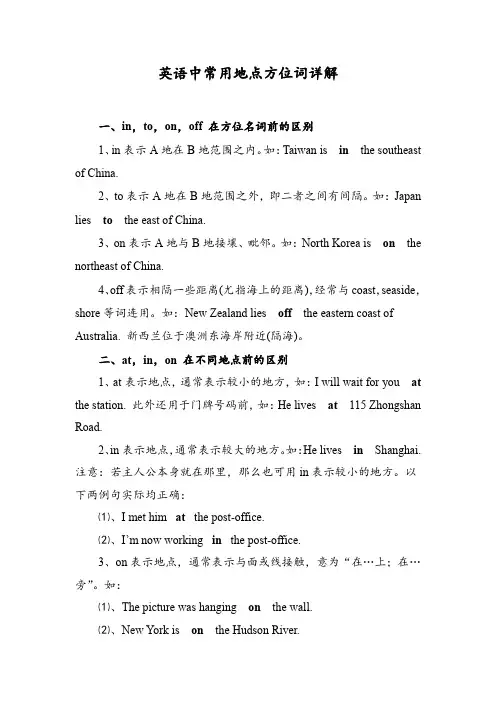
英语中常用地点方位词详解一、in,to,on,off 在方位名词前的区别1、in表示A地在B地范围之内。
如:Taiwan is in the southeast of China.2、to表示A地在B地范围之外,即二者之间有间隔。
如:Japan lies to the east of China.3、on表示A地与B地接壤、毗邻。
如:North Korea is on the northeast of China.4、off表示相隔一些距离(尤指海上的距离),经常与coast,seaside,shore等词连用。
如:New Zealand lies off the eastern coast of Australia. 新西兰位于澳洲东海岸附近(隔海)。
二、at,in,on 在不同地点前的区别1、at表示地点,通常表示较小的地方,如:I will wait for you at the station. 此外还用于门牌号码前,如:He lives at115 Zhongshan Road.2、in表示地点,通常表示较大的地方。
如:He lives in Shanghai. 注意:若主人公本身就在那里,那么也可用in表示较小的地方。
以下两例句实际均正确:⑴、I met him at the post-office.⑵、I’m now working in the post-office.3、on表示地点,通常表示与面或线接触,意为“在…上;在…旁”。
如:⑴、The picture was hanging on the wall.⑵、New York is on the Hudson River.三、near,by,beside,at 表示“在…附近”的区别1、near表示相对的近,实际距离有可能很远。
如:Suzhou is near Shanghai.2、by和beside都表示靠近,实际距离不远,但beside比by更具体地表示出“在…旁边”的意思。
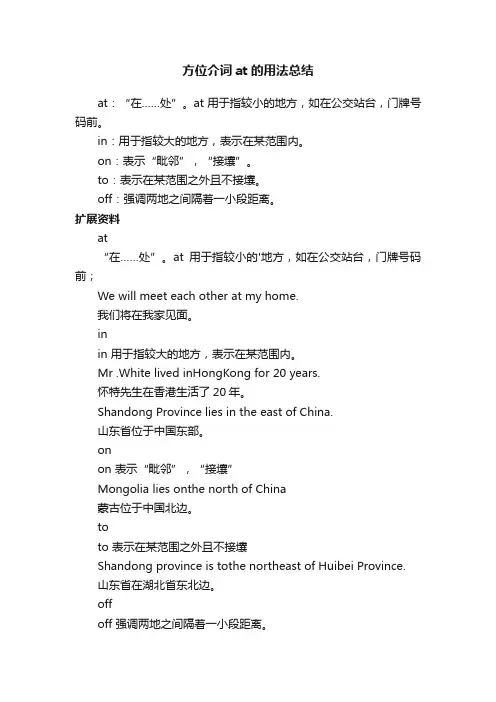
方位介词at的用法总结
at:“在……处”。
at用于指较小的地方,如在公交站台,门牌号码前。
in:用于指较大的地方,表示在某范围内。
on:表示“毗邻”,“接壤”。
to:表示在某范围之外且不接壤。
off:强调两地之间隔着一小段距离。
扩展资料
at
“在……处”。
at用于指较小的'地方,如在公交站台,门牌号码前;
We will meet each other at my home.
我们将在我家见面。
in
in 用于指较大的地方,表示在某范围内。
Mr .White lived inHongKong for 20 years.
怀特先生在香港生活了20年。
Shandong Province lies in the east of China.
山东省位于中国东部。
on
on 表示“毗邻”,“接壤”
Mongolia lies onthe north of China
蒙古位于中国北边。
to
to 表示在某范围之外且不接壤
Shandong province is tothe northeast of Huibei Province.
山东省在湖北省东北边。
off
off 强调两地之间隔着一小段距离。
Lily lives in a flat just off Park Avenue. 莉莉住在离派克大街不远的一套公寓里。
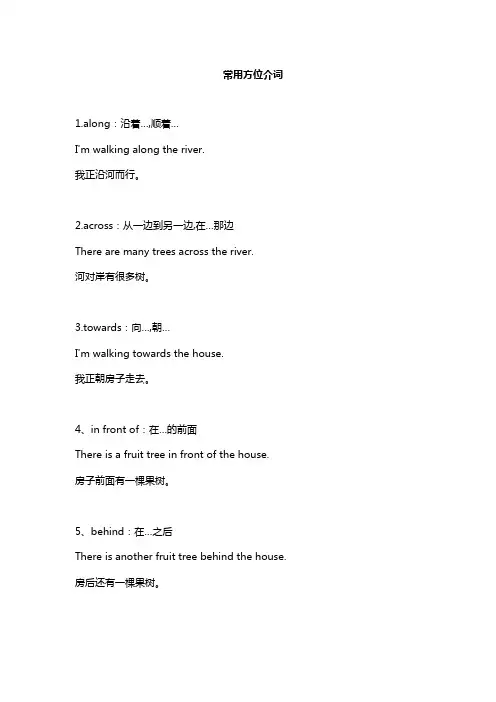
常用方位介词1.along:沿着…,顺着…I'm walking along the river.我正沿河而行。
2.across:从一边到另一边,在…那边There are many trees across the river.河对岸有很多树。
3.towards:向…,朝…I'm walking towards the house.我正朝房子走去。
4、in front of:在…的前面There is a fruit tree in front of the house.房子前面有一棵果树。
5、behind:在…之后There is another fruit tree behind the house. 房后还有一棵果树。
6、into:到…里,进入内部I want to go into the house.我想走进房子。
7、inside:在…的里面,在…内部I am inside the house now.我正在房子里。
8、outside:在…外面Now I am outside the house.我现在来到房外。
9、in:在…里,表示在含有空间感的范围或物体之中There is nobody in the house.房子里面没有人。
10、above:在…之上,表示高于,不是垂直的There are lots of apples above my head.我的头顶上有很多苹果。
11、under:在…正下方,强调垂直在…之下I want to have a rest under the tree.我想在树下休息一会儿。
12、off:从…脱落,从…掉下on:在…之上,与…表面相接触An apple falls off the tree and hits me on the head. 一只苹果从树上掉下砸在我的头上。
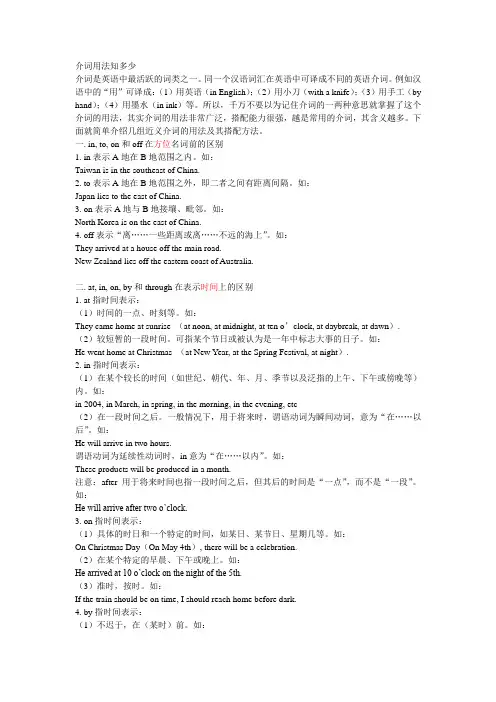
介词用法知多少介词是英语中最活跃的词类之一。
同一个汉语词汇在英语中可译成不同的英语介词。
例如汉语中的“用”可译成:(1)用英语(in English);(2)用小刀(with a knife);(3)用手工(by hand);(4)用墨水(in ink)等。
所以,千万不要以为记住介词的一两种意思就掌握了这个介词的用法,其实介词的用法非常广泛,搭配能力很强,越是常用的介词,其含义越多。
下面就简单介绍几组近义介词的用法及其搭配方法。
一. in, to, on和off在方位名词前的区别1. in表示A地在B地范围之内。
如:Taiwan is in the southeast of China.2. to表示A地在B地范围之外,即二者之间有距离间隔。
如:Japan lies to the east of China.3. on表示A地与B地接壤、毗邻。
如:North Korea is on the east of China.4. off表示“离……一些距离或离……不远的海上”。
如:They arrived at a house off the main road.New Zealand lies off the eastern coast of Australia.二. at, in, on, by和through在表示时间上的区别1. at指时间表示:(1)时间的一点、时刻等。
如:They came home at sunrise (at noon, at midnight, at ten o’clock, at daybreak, at dawn). (2)较短暂的一段时间。
可指某个节日或被认为是一年中标志大事的日子。
如:He went home at Christmas (at New Year, at the Spring Festival, at night).2. in指时间表示:(1)在某个较长的时间(如世纪、朝代、年、月、季节以及泛指的上午、下午或傍晚等)内。

介词用法知多少介词是英语中最活跃的词类之一。
同一个汉语词汇在英语中可译成不同的英语介词。
例如汉语中的“用”可译成:(1)用英语(in English);(2)用小刀(with a knife);(3)用手工(by hand);(4)用墨水(in ink)等。
所以,千万不要以为记住介词的一两种意思就掌握了这个介词的用法,其实介词的用法非常广泛,搭配能力很强,越是常用的介词,其含义越多。
下面就简单介绍几组近义介词的用法及其搭配方法。
一. in, to, on和off在方位名词前的区别1. in表示A地在B地范围之内。
如:is in the southeast of .2. to表示A地在B地范围之外,即二者之间有距离间隔。
如:lies to the east of .3. on表示A地与B地接壤、毗邻。
如:is on the east of .4. off表示“离……一些距离或离……不远的海上”。
如:They arrived at a house off the main road.lies off the eastern coast of .二. at, in, on, by和through在表示时间上的区别1. at指时间表示:(1)时间的一点、时刻等。
如:They came home at sunrise (at noon, at midnight, at ten o’clock, at daybreak, at dawn).(2)较短暂的一段时间。
可指某个节日或被认为是一年中标志大事的日子。
如:He went home at Christmas (at New Year, at the Spring Festival, at night).2. in指时间表示:(1)在某个较长的时间(如世纪、朝代、年、月、季节以及泛指的上午、下午或傍晚等)内。
如:in 2004, in March, in spring, in the morning, in the evening, etc(2)在一段时间之后。
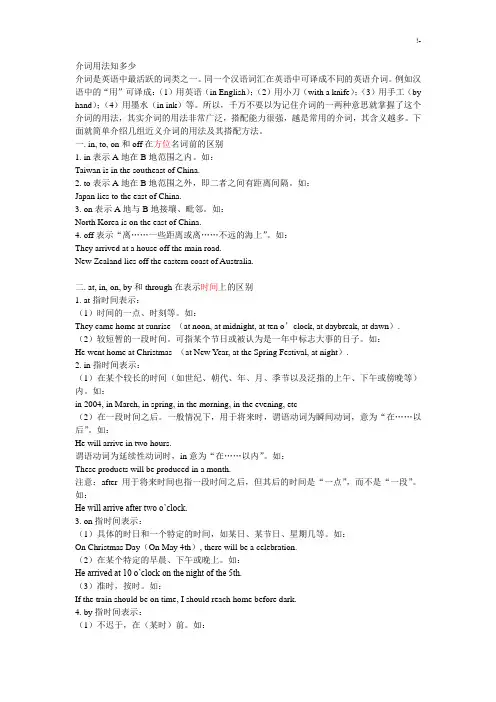
介词用法知多少介词是英语中最活跃的词类之一。
同一个汉语词汇在英语中可译成不同的英语介词。
例如汉语中的“用”可译成:(1)用英语(in English);(2)用小刀(with a knife);(3)用手工(by hand);(4)用墨水(in ink)等。
所以,千万不要以为记住介词的一两种意思就掌握了这个介词的用法,其实介词的用法非常广泛,搭配能力很强,越是常用的介词,其含义越多。
下面就简单介绍几组近义介词的用法及其搭配方法。
一. in, to, on和off在方位名词前的区别1. in表示A地在B地范围之内。
如:Taiwan is in the southeast of China.2. to表示A地在B地范围之外,即二者之间有距离间隔。
如:Japan lies to the east of China.3. on表示A地与B地接壤、毗邻。
如:North Korea is on the east of China.4. off表示“离……一些距离或离……不远的海上”。
如:They arrived at a house off the main road.New Zealand lies off the eastern coast of Australia.二. at, in, on, by和through在表示时间上的区别1. at指时间表示:(1)时间的一点、时刻等。
如:They came home at sunrise (at noon, at midnight, at ten o’clock, at daybreak, at dawn). (2)较短暂的一段时间。
可指某个节日或被认为是一年中标志大事的日子。
如:He went home at Christmas (at New Year, at the Spring Festival, at night).2. in指时间表示:(1)在某个较长的时间(如世纪、朝代、年、月、季节以及泛指的上午、下午或傍晚等)内。
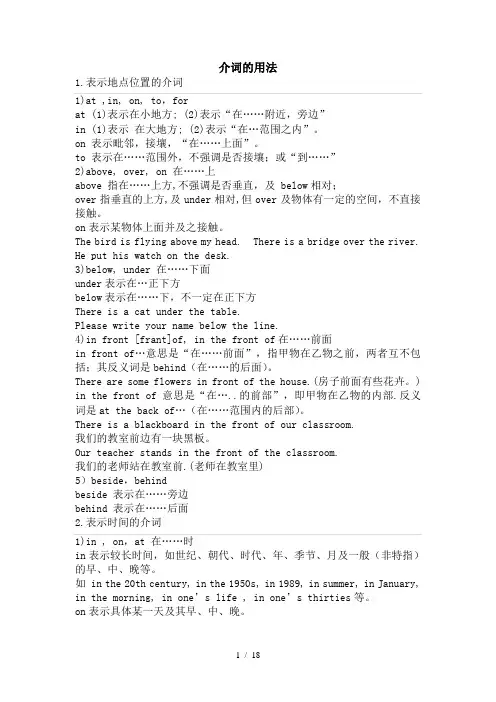
介词的用法1.表示地点位置的介词1)at ,in, on, to,forat (1)表示在小地方; (2)表示“在……附近,旁边”in (1)表示在大地方; (2)表示“在…范围之内”。
on 表示毗邻,接壤,“在……上面”。
to 表示在……范围外,不强调是否接壤;或“到……”2)above, over, on 在……上above 指在……上方,不强调是否垂直,及 below相对;over指垂直的上方,及under相对,但over及物体有一定的空间,不直接接触。
on表示某物体上面并及之接触。
The bird is flying above my head. There is a bridge over the river. He put his watch on the desk.3)below, under 在……下面under表示在…正下方below表示在……下,不一定在正下方There is a cat under the table.Please write your name below the line.4)in front [frant]of, in the front of在……前面in front of…意思是“在……前面”,指甲物在乙物之前,两者互不包括;其反义词是behind(在……的后面)。
There are some flowers in front of the house.(房子前面有些花卉。
) in the front of 意思是“在…..的前部”,即甲物在乙物的内部.反义词是at the back of…(在……范围内的后部)。
There is a blackboard in the front of our classroom.我们的教室前边有一块黑板。
Our teacher stands in the front of the classroom.我们的老师站在教室前.(老师在教室里)5)beside,behindbeside 表示在……旁边behind 表示在……后面2.表示时间的介词1)in , on,at 在……时in表示较长时间,如世纪、朝代、时代、年、季节、月及一般(非特指)的早、中、晚等。
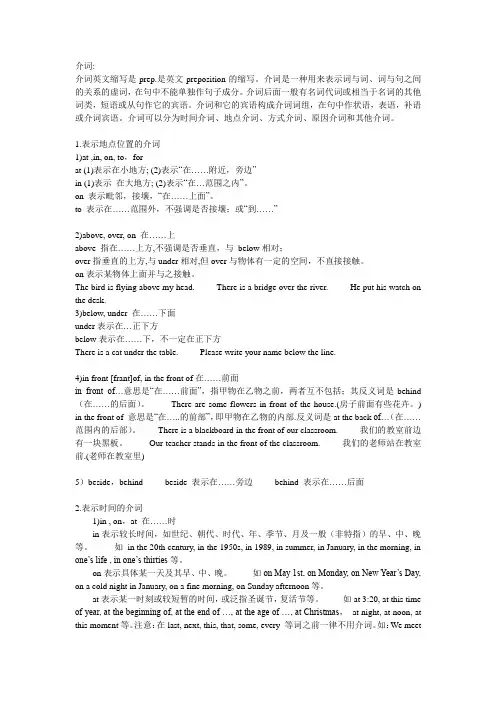
介词:介词英文缩写是prep.是英文preposition的缩写。
介词是一种用来表示词与词、词与句之间的关系的虚词,在句中不能单独作句子成分。
介词后面一般有名词代词或相当于名词的其他词类,短语或从句作它的宾语。
介词和它的宾语构成介词词组,在句中作状语,表语,补语或介词宾语。
介词可以分为时间介词、地点介词、方式介词、原因介词和其他介词。
1.表示地点位置的介词1)at ,in, on, to,forat (1)表示在小地方; (2)表示“在……附近,旁边”in (1)表示在大地方; (2)表示“在…范围之内”。
on 表示毗邻,接壤,“在……上面”。
to 表示在……范围外,不强调是否接壤;或“到……”2)above, over, on 在……上above 指在……上方,不强调是否垂直,与below相对;over指垂直的上方,与under相对,但over与物体有一定的空间,不直接接触。
on表示某物体上面并与之接触。
The bird is flying above my head. There is a bridge over the river. He put his watch on the desk.3)below, under 在……下面under表示在…正下方below表示在……下,不一定在正下方There is a cat under the table. Please write your name below the line.4)in front [frant]of, in the front of在……前面in front of…意思是“在……前面”,指甲物在乙物之前,两者互不包括;其反义词是behind (在……的后面)。
There are some flowers in front of the house.(房子前面有些花卉。
) in the front of 意思是“在…..的前部”,即甲物在乙物的内部.反义词是at the back of…(在……范围内的后部)。
表示方位和方向的介词用法表示位置的介词有:at, in, by, near, between, under表示方向的介词有: to, into, out, out of, across, along, through1 at表示在某地点,强调在某个位置点例:I met her at the school gate this morning. 我今天早上在校门口遇见了她。
at也用于街道号码前例:She lives at 78 Nanjing Road. 她住在南京路78号。
She lives on Nanjing Road. 她住在南京路。
(街道前无号码时用on)She lives in Queen Street. 她住在女王街。
(住在某大街用in)2 in表示“在某区域内,在一个空间的内部,在……里面”例:She was born in Nanjing. 她生于南京。
提示:两个地名连用时,小的用at,大的用in.例:He arrived at London in England last week. 他上周到达英国伦敦。
Theywill meet at Washington in America. 他们将在美国华盛顿会面。
3 on表示“在……上”,并与之相接触例:He put the dictionary on the desk. 他把词典放在桌子上。
比较英国英语和美国英语的不同介词用法:在路上 on the road (美)in the road (英)在街上 on the street (美)in the street (英)在周末 on the weekend (美)at the weekend (英)在这个队 on the team (美)in the team (英)4 under和below表示“在……的正下方”,指垂直上下。
below表示“低于某物”,只表示位置低于,但不是在正下方。
以下是常见的英语方位介词的列表:
1.Above - 在...之上
2.Across - 穿过,横过
3.After - 在...后面
4.Against - 靠着,依靠
5.Along - 沿着
6.Among - 在...之中
7.Around - 在周围
8.At - 在...处
9.Behind - 在...后面
10.Below - 在...之下
11.Beside - 在...旁边
12.Between - 在...之间
13.Beyond - 在...之外
14.By - 在...旁边,靠近
15.Down - 沿着,向下
16.From - 从...出发
17.In - 在...里面
18.Inside - 在...内部
19.Into - 进入
20.Near - 在...附近
21.Off - 离开
22.On - 在...上面
23.Onto - 到...上面
24.Out - 出去
25.Outside - 在...外部
26.Over - 在...上方
27.Past - 经过
28.Round - 绕过
29.Through - 穿过
30.To - 到...处
31.Toward(s) - 朝向
32.Under - 在...下面
33.Up - 向上
34.With - 带着
这些方位介词可以用来描述位置、方向和关系,帮助我们准确地表达位置和运动。
请注意,一些介词可能有多种用法和意义,具体用法会根据上下文而有所变化。
表示地点位置的介词w qsa 1)at ,in, on, to,for at (1)表示在小地方; (2)表示“在……附近,旁边”in (1)表示在大地方; (2)表示“在…范围之内”。
on 表示毗邻,接壤,“在……上面”。
to 表示在……范围外,不强调是否接壤;或“到……”2)above, over, on 在……上above 指在……上方,不强调是否垂直,与below相对;over指垂直的上方,与under 相对,但over与物体有一定的空间,不直接接触。
on表示某物体上面并与之接触。
The bird is flying above my head. There is a bridge over the river. He put his watch on the desk. 3)below, under 在……下面under表示在…正下方below表示在……下,不一定在正下方There is a cat under the table. Please write your name below the line. 4)in front [frant]of, in the front of在……前面in front of…意思是“在……前面”,指甲物在乙物之前,两者互不包括;其反义词是behind(在……的后面)。
There are some flowers in front of the house.(房子前面有些花卉。
) in the front of 意思是“在…..的前部”,即甲物在乙物的内部.反义词是at the back of…(在……范围内的后部)。
There is a blackboard in the front of our classroom. 我们的教室前边有一块黑板。
Our teacher stands in the front of the classroom. 我们的老师站在教室前.(老师在教室里) 5)beside,behind beside 表示在……旁边behind 表示在……后面2.表示时间的介词1)in , on,at 在……时in表示较长时间,如世纪、朝代、时代、年、季节、月及一般(非特指)的早、中、晚等。
介词一、In介词prep.1.(表示位置)在…里面; 在, 于; 在…部位上I could feel the tension in the room.我可以感觉到房间里的紧张气氛。
They live in France.他们住在法国。
2.(表示时间)在…时期, 在…之后, 在过程中In her twenties and thirties she had had no difficulty getting jobs.她在二三十岁时找工作一点也不困难。
I cannot see you now, come back in half an hour.我现在不能见你, 半小时后回来。
3.(表示方向)往…内, 朝…方向I saw him go in the shop.我看到他走进了商店。
4.(表示状态)处于…之中, 在…情况下Martin was in his pyjamas.马丁穿着睡衣。
They were living in terrible poverty.他们生活在极度贫困之中。
5.(表示方式)用, 以, 按, 乘, 以…形式They were speaking in Italian.他们在讲意大利语。
They went up in the lift.他们乘电梯上楼了。
6.(表示原因)由于, 为了He went in fear of his life.他为自己的性命担忧, 所以走了。
7.(表示领域, 范围)在…以内It is not in my power to do that.做那事非我力所能及。
8.(表示结果)当做, 作为What did you give him in return?你给他什么作为报答呢?9.(表示目的)为了They set off in search of the lost child.他们出发去寻找走失的孩子。
10.[表示职业、活动等]从事于 参加11.[表示数量、程度、比例]按 以 从…中12.[表示品质、能力等]在…之中 在…身上I don't think he had it in him.我认为他没这个本事。